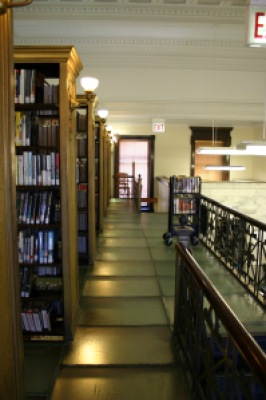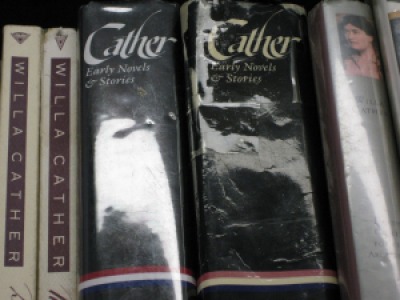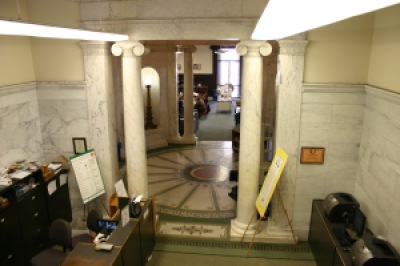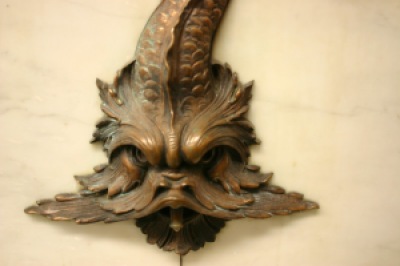Timothy B. Blackstone Memorial Library
(aka Blackstone Branch Library)
4904 South Lake Park Avenue
Chicago, IL 60615
(312) 747-0511
website
Architect: Solon S. Beman
Cost: $250,000
Square feet: 13, 794
Dedication: January 8, 1904
Last May I stumbled upon the James Blackstone Memorial Library in Branford, CT. It’s a stunning library and if you’d like to check out my post on that library, please click here.
While doing research on early Chicago area libraries my curiosity was piqued when I found out that the first branch of the city library is named after another Blackstone. Timothy B. Blackstone (1829-1900) built the James Blackstone Memorial Library in Branford as a tribute to his father, James Blackstone (1793-1886). That library opened its doors to the public on June 17, 1896.
Following Timothy’s death in 1900, his wife, Isabella Farnsworth Norton, fulfilled her husband’s wishes and built a memorial library in his honor. Prior to his death, Mr. Blackstone had purchased the tract of land for the building. Construction began in June 1902 and was finished in January 1904.
 |
| Beman also designed the Blackstone Memorial Library in Branford, CT. Both are based upon the Erechtheum. |
 |
| Carved ornamental detail that flanks the bench just to the left of the front entrance. |
 |
| Column and ornamental detail. |
 |
| Plaque from the 100-year celebration inlaid in sidewalk out front. |
 |
| Detail of plaque: contemporary and classic writers. |
 |
| Outer doors are bronze plated with a solid copper core and weight approximately 800 pounds each. |
 |
| Inner doors are brass and weight 150 pounds each. |
 |
| Original tile mosaic in the foyer. |
 |
| The light fixture in the foyer. |
 |
| When you step into the library, you stand under this colorful dome. The four murals painted by Oliver Dennett Grover are a sight to behold. |
 |
| Another view. The murals were restored in 2009. Each measures 14 by 9 feet. |
 |
| LITERATURE: In this mural, the central figure has a scroll and pen in hand surrounded by the figures of an old man holding a book, representing history; a woman playing the lute, representing poetry; a woman holding a mask, representing drama, and a woman casting flowers representing fiction. The woman, as described by Grover is “a girl of present-day type scattering the poesies of human thought” (Description from library pamphlet). |
 |
| ART: The central figure in this mural holds a mirror and is surrounded by women depicted as a painter, a sculptor, an architect, and a harpist to represent the four branches of the Fine Arts (Description from library pamphlet). |
 |
| SCIENCE: The woman at the center of this panel holds a lamp, symbolizing Science. She is encircled by a man with a beaker, representing chemistry; a woman with a telescope, representing astronomy; a woman with a miner’s hammer, representing geology, and a woman feeding a peacock, representing zoology (Description from library pamphlet). |
 |
| LABOR: Labor is symbolized by a woman holding a mason’s trowel accompanied by a miner, farmer, weaver, and the figure of a woman carrying a steam locomotive (Description from library pamphlet). |
 |
| A view from the rotunda of the entrance. |
 |
| Looking from the rotunda to the stacks, which are to left (south) when you walk in. To the right (north) is the main reading room and straight ahead (west) is a smaller reading room that was originally intended for children. |
 |
| Majestic light. |
 |
| Original mosaic mandala. |
 |
| Circulation desk to the right, librarian’s office to the left, stacks straight ahead. |
 |
| Bronze medallion of Mr. Blackstone. |
 |
| On the second floor of the stacks. Notice the glass floor. Have you ever seen such a floor in a library? |
 |
| Floor and railing detail. |
 |
| Ceiling shot and additional light source. |
 |
| Detail of the stained glass panels in the ceiling. |
 |
| Bookcase and light fixture detail. |
 |
| Some well-used Cather on the shelf. |
 |
| Looking down from the second floor at circulation. In the distance, you can see the main reading room. |
 |
| Back on the ground floor. This is the most awesome water fountain I’ve seen in a library or just about anywhere else for that matter. It’s just outside the librarian’s office door. |
 |
| Frontal view. |
 |
| Not a face to be messed with. If the librarian didn’t keep kids from horsing around the water fountain, this face may have. |
 |
| The stacks on the ground floor aren’t as well-lit, but it just makes the lighting and glass floor that much more dramatic. |
 |
| The Children’s Room, a WPA project, was added in 1939. It’s 96 by 35 feet. You get to this room by walking through the stacks and down a short hallway. |
 |
| Another view of the children’s room. |
 |
|
When you walk into the library and take a right, you enter the main reading room which is 30 by 45 feet. This room now has some computers in it but retains its white plaster walls with warm dark bookcases and mahogany wainscoting. During the two recent visits that I made, the room was full of people working, so I wasn’t able to take pictures that respect people’s privacy. However, this beautiful old globe caught my eye and I can’t help but wonder how many hands have spun it over the decades.
|
 |
| The back of the library. |
If you live in Chicago, I encourage you to take a couple of hours and visit this historic and unique library. If you’re a tourist, the library is just minutes from The Museum of Science & Industry and President Obama’s neighborhood.
Like this:
Like Loading...
Related




































